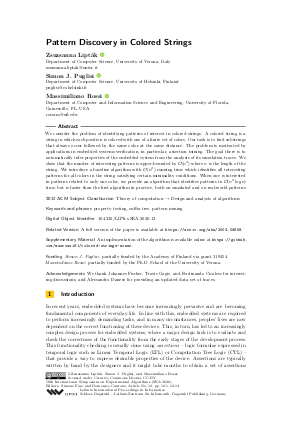@InProceedings{liptak_et_al:LIPIcs.SEA.2020.12,
author = {Lipt\'{a}k, Zsuzsanna and Puglisi, Simon J. and Rossi, Massimiliano},
title = {{Pattern Discovery in Colored Strings}},
booktitle = {18th International Symposium on Experimental Algorithms (SEA 2020)},
pages = {12:1--12:14},
series = {Leibniz International Proceedings in Informatics (LIPIcs)},
ISBN = {978-3-95977-148-1},
ISSN = {1868-8969},
year = {2020},
volume = {160},
editor = {Faro, Simone and Cantone, Domenico},
publisher = {Schloss Dagstuhl -- Leibniz-Zentrum f{\"u}r Informatik},
address = {Dagstuhl, Germany},
URL = {https://drops.dagstuhl.de/entities/document/10.4230/LIPIcs.SEA.2020.12},
URN = {urn:nbn:de:0030-drops-120862},
doi = {10.4230/LIPIcs.SEA.2020.12},
annote = {Keywords: property testing, suffix tree, pattern mining}
}

 Creative Commons Attribution 3.0 Unported license
Creative Commons Attribution 3.0 Unported license

































